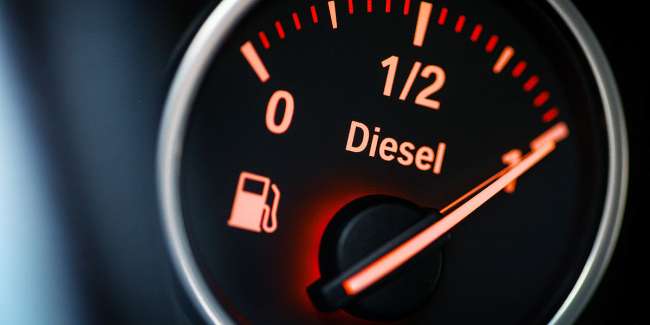Staff Reporter
Diesel Average Price Falls 2.1¢ to $3.011 a Gallon

[Stay on top of transportation news: Get TTNews in your inbox.]
The U.S. average retail price of diesel continued to drop, falling 2.1 cents to $3.011 a gallon, the Department of Energy reported Aug. 12.
It was the sixth straight drop in diesel prices, totaling 4.4 cents, since July 15.
Diesel costs 20.6 cents less than it did a year ago, when it was $3.217 per gallon, DOE reported.
Regional prices fell everywhere. The steepest decline was in New England, where the price of a gallon of diesel fell by 3.4 cents to $3.073.

In our first episode of RoadSigns, Season Three, we ask: How Can Trucking Take Fuel Economy to the Next Level? Hear a snippet from host Seth Clevenger, above, and get the full program by going to RoadSigns.TTNews.com.
California, which saw a 3.1-cent decline, continues to have the highest diesel price in the nation at $3.909 per gallon. The cheapest price was reported in the Gulf Coast states at $2.763 per gallon.
The national average price of gasoline also fell, by 6.4 cents to $2.624 a gallon, which is 21.9 cents cheaper than a year ago at this time.
West Texas Intermediate oil is likely to stay $50 to $60 per barrel for the short term, said Denton Cinquegrana, chief oil analyst for the Oil Price Information Service. He noted that the markets are timid because of high inventories and U.S. trade disputes with China.
“There is a comfort zone there,” Cinquegrana told Transport Topics. “I think we are going to stick around the $55 mark for at least the next couple of weeks.”
On July 14, WTI crude for September settled $1.87 lower at $55.23 a barrel on the New York Mercantile Exchange. The contract slipped below its 50- and 200-day moving averages, a bearish harbinger, Bloomberg News reported.
Brent oil for October settlement decreased 3% to $59.48. The international benchmark traded at a $4.23 premium to same-month WTI futures.
One reason for the oil price drops was swelling U.S. crude stockpiles, which reinforced fears about an economic slowdown, Bloomberg News reported. American crude inventories posted a surprise increase for the second straight week, U.S. data showed. That accelerated a flight from commodities and other higher-risk assets as sagging Treasury yields sounded alarm bells for a recession.
Crude stockpiles grew by 1.58 million barrels, the U.S. Energy Information Administration said. Still, exports rebounded, gasoline stocks shrank and gasoline demand climbed to its highest in almost 30 years of record-keeping, according to Bloomberg News.
Yet oil also got caught up in general concerns about the economy. Futures closed down 3.3% in New York, joining a slide in equities that saw 98% of the stocks in the S&P 500 Index drop. Fears of a recession spread after the yield on 10-year U.S. Treasuries fell below the rate on the two-year for the first time since 2007. The S&P 500 dropped as much as 3%, Bloomberg News reported.
The U.S. oil inventory numbers surprised most analysts, Cinquegrana said, because there was anticipation of a fairly big drawdown, if only because people drive more in August.
“We’re in the summer,” Cinquegrana said. “You would expect you would be pulling more out of inventory.”
Given the historical instability in oil prices, truck manufacturers are always looking to increase mileage and aerodynamics while decreasing emissions. A spokesperson for a division of Daimler Trucks North America told TT that the company has certain standards for its fuel usage and aerodynamic design.
“The tractor should have an optimally sloped hood, aerodynamic mirrors, integrated antennas, a bumper with an integrated air deflector, and full chassis side fairings, side extenders and door seals,” said Kelly Gedert, director of product marketing for Freightliner Truck and Detroit Components, a Daimler subsidiary. “Trailer enhancements may include trailer skirts, trailer tail, nose cone and wheel covers. The trailer gap should be as tight as possible based on the trailer application. Consider specs that manage airflow and minimize drag.”

Gedert
Tires should be low-rolling-resistance models and operated at tire manufacturers’ recommended air pressures, Gedert said.
“Axle alignment on the tractor and trailer is also critical to achieve optimal fuel efficiency,” Gedert said in an email.
“The engine, transmission and axles should be designed to work together,” Gedert said. “Detroit rear axles have features such as lower sump volume, gear-set finishing, friction-reducing gear cutting and optional axle lubrication management that reduces parasitic loss and improves fuel economy.”
Finally, the last things on the road: the driver, and planning the best route.
Driver experience can contribute to fuel economy, Gedert said, while highway speeds around 62 mph have been found to provide a positive fuel-economy return. Terrain and traffic can be detrimental to fuel efficiency, Gedert added.




